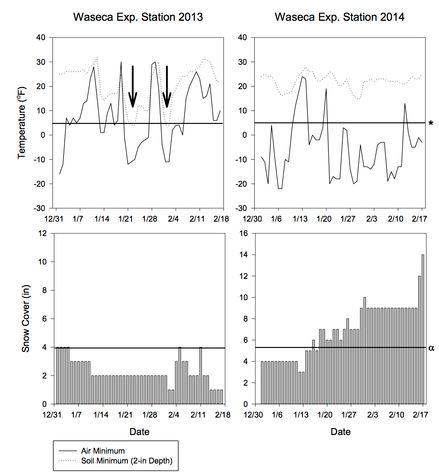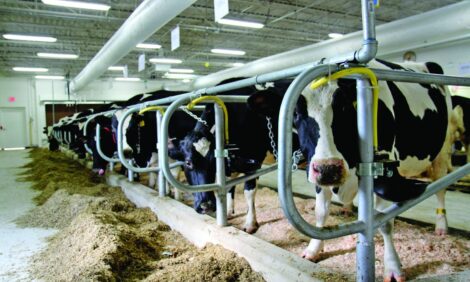



Predicting the Future: Will Alfalfa Survive This Harsh Winter?
The polar vortex and a prolonged cold weather have led many producers to wonder: Will forage stands survive the winter?Crop specialist at the University of Minnesota, Phyllis Bongard, writes that Minnesota Alfalfa fields have had the likelihood of injury reduced due to snow cover.
Over the past two and half months as the new U of MN Forage and Cropping System Extension Agronomist, the one question I have been asked the most is, "Are you surviving the winter?"
Being from the southern US, I replied that I have now experienced real winter, writes Mrs Bongard.
Some of these experiences have been novel and interesting, such as tossing boiling water into the air and watching it become snow, and blowing bubbles in -15°F weather (if you not have tried the bubbles, I highly recommend it), whereas other experiences (truck not starting because its so cold) have been less thrilling.
This question about "surviving the winter" is an important one when considering the devastating impact of the 2012-2013 winter on alfalfa stands throughout Minnesota. If you are an Alfalfa producer, the question of alfalfa winter injury, and to a greater extent winterkill, is definitely on your mind as it is on mine.
Winter injury and winterkill of Alfalfa can be tricky to predict during an average winter where adequate snow cover (4 to 6 inches) persists throughout the season. However, this winter as been anything but "average" and with headlines such as: "Out of the blizzard, into the icebox; low temperature records may be shattered" (NBC News 1/4/2014); "Deep Freeze Recap: Coldest Temperatures of the Century for Some" (The Weather Channel 1/10/2014); "More frigid cold prompts Minnesota schools to cancel Thursday classes" (StarTribune 1/23/2014), and my personal favorite, "Minnesota weather remains frigid as heat wave hits Alaska" (KARE 11 News 1/28/2014); the question arises, how likely is winter injury and winterkill in Alfalfa this winter?
As mentioned above, severe cold temperatures measured at the alfalfa crown from 15 and 5°F and below can cause damage, and during prolonged exposure, kill the plant. Even if the plants are not killed, the full extent of the damage is not until the plants reach 6 inches of spring growth (early May).
Snow cover is essential in preventing soil temperatures from falling into the ranges where alfalfa is susceptible to winter injury and winterkill. Notice for both 2013 and 2014 how air temperatures dropped below the 5°F (e.g. bold black line, Figure 1), but what is more important than the air temperature is the temperature observed at the crown.
In 2013 soil temperatures (e.g. 2-inches) were at or below 15°F (e.g. range for winter injury) for the months of January and February, and even worse, soil temperatures were measured below 5°F (Figure 1, black arrows).
Even though the air temperatures were less severe than those experienced this year, the increased snow cover in 2014 has insulated the soil, preventing extreme changes in soil temperature, thus reducing the likelihood of alfalfa winter injury. Soil temperature at a 2 inch depth has mostly been above 20 F with periods where it reached near 16 F when air temperatures reached near-22°F. This illustrates the importance of managing alfalfa stands to increase snow cover retention.
Figure 1. Temperature and snow depth for Waseca Experiment Station during the winters of 2013 and 2014. *Critical temperature threshold for alfalfa winter injury and winterkill. **Minimum snow depth to buffer and insulate soil temperature from extreme air temperatures.
For the remainder of the winter and even into early spring, we need to watch out for alternative freeze and thaw cycles. These cycles can adversely affect alfalfa in several ways.
(i) As the snow melts and refreezes, ice sheets can form. These ice sheets reduce the insulation factor of the remaining snow, thereby lowering the soil temperature at the crown, and much like the freezer bags use to keep your meat from spoiling in the freezer, the ice sheet restrict the diffusion of oxygen to the roots. The lower diffusion rates of oxygen to the roots, combined with the increased levels of carbon dioxide respiring from the roots, creates an anoxic zone (think low oxygen).
(ii) The freeze-thaw cycles of the soil can physically lift alfalfa plants out of the soil via heaving. The heaved alfalfa crown is increasingly exposed to the elements and is more susceptible to winter injury. In extreme cases, alfalfa lateral roots can become severed, reducing the winter survivability and spring productivity. Typically heaving is more of an issue in wet, saturated soils, and less of an issue in well drained soils.
(iii) Temperatures above 40°F can cause alfalfa buds to break dormancy. Once dormancy is broken, buds are much more susceptible to freezing damage. Plants with dead buds grow unevenly and slowly in the spring.
We cannot control the weather, or predict how severe the winter will be, as production decisions are made the prior year. However, we do possess tools to help decrease the incidences of winter injury, and many of these tools and management strategies are placed in motion long before the winter. These controllable management strategies include:
- Selecting varieties with greater winter hardiness and disease resistance. For detailed descriptions of variety, disease resistance, and winter hardiness, see Minnesota Variety Trial Results 2012.
- Managing younger stands. Stand age is important since older stands are more exposed to cumulative stressors of plant diseases and physical injury than younger stands, resulting in reduced winter survivability in the older stands.
- Soil K Level. Soil potassium (potash) is very important in enhancing alfalfa tolerance to winter injury. Management of soil nutrients Phosphorus, Boron, and Sulfur along with pH (<6.5) is critical to ensure winter survivability.
- Soil drainage is important from both a disease management and ice sheeting point of view.
Harvest management combined with the above management strategies provide producers with increased control over winter survivability. More frequent cutting will normally cause more plant stress (reduction in root reserves).
- In general, three cuts are less risky than four-cuts in southern Minnesota. The last harvest in the three-cut system must occur before September 1st. By doing so, the Alfalfa has enough time to regrow and accumulate carbohydrate reserves in concert with undergoing the normal fall dormancy changes.
- When considering four-cut systems, delaying the last cut until October 15th instead of September 15th, can reduce the likelihood of winter injury since there is minimal chance of reducing root reserves through fall regrowth.
- Stubble height management from un-harvested plant residue insulates the soil, catches snow for insulation, and by shading the soil surface from sunlight can minimize freezing and thawing cycles.
Given the complex interactions, both climate-related and cultural, it is difficult to assess the degree of winter injury in Alfalfa. However, with the amount of snow-cover throughout the state, currently I think the risk for winterkill is minimal, but only time will tell.




